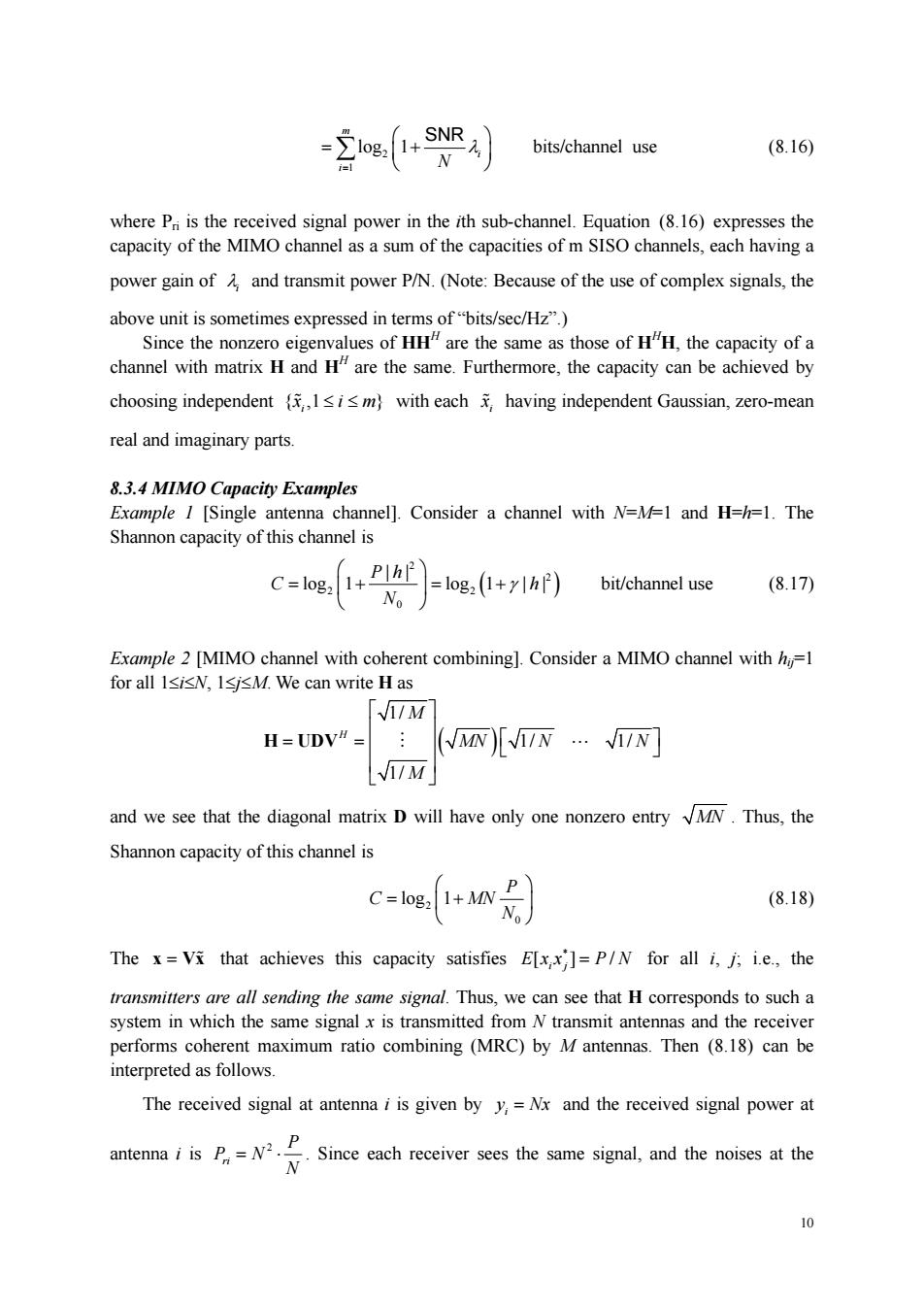正在加载图片...

-交e刘 bits/channel use (8.16) where Pn is the received signal power in the ith sub-channel.Equation (8.16)expresses the capacity of the MIMO channel as a sum of the capacities of m SISO channels,each having a power gain ofand transmit power P/N.(Note:Because of the use of complex signals,the above unit is sometimes expressed in terms of"bits/sec/Hz") Since the nonzero eigenvalues of HH"are the same as those of HH,the capacity of a channel with matrix H and H are the same.Furthermore,the capacity can be achieved by choosing independent1sism with each having independent Gaussian,zero-mean real and imaginary parts. 8.3.4 MIMO Capacity Examples Example I [Single antenna channel].Consider a channel with N=M=1 and H=h=1.The Shannon capacity of this channel is C=log:1+P =log2(1+y1h) bit/channel use (8.17) Example 2 [MIMO channel with coherent combining].Consider a MIMO channel withh=1 for all IsisN,IsjsM.We can write Has 「/M H=UDV#= (MN)[/N./N 1/M and we see that the diagonal matrix D will have only one nonzero entry M.Thus,the Shannon capacity of this channel is c-w别 (8.18) The x=V that achieves this capacity satisfies E[x]=P/N for all i.j.i.e.,the transmitters are all sending the same signal.Thus,we can see that H corresponds to such a system in which the same signal x is transmitted from N transmit antennas and the receiver performs coherent maximum ratio combining (MRC)by M antennas.Then (8.18)can be interpreted as follows The received signal at antenna i is given by y=Nx and the received signal power at P antenna i is P.=N2 Since each receiver sees the same signal,and the noises at the10 2 1 log 1 m i i N SNR bits/channel use (8.16) where Pri is the received signal power in the ith sub-channel. Equation (8.16) expresses the capacity of the MIMO channel as a sum of the capacities of m SISO channels, each having a power gain of i and transmit power P/N. (Note: Because of the use of complex signals, the above unit is sometimes expressed in terms of “bits/sec/Hz”.) Since the nonzero eigenvalues of HHH are the same as those of HHH, the capacity of a channel with matrix H and HH are the same. Furthermore, the capacity can be achieved by choosing independent { ,1 } i x i m with each i x having independent Gaussian, zero-mean real and imaginary parts. 8.3.4 MIMO Capacity Examples Example 1 [Single antenna channel]. Consider a channel with N=M=1 and H=h=1. The Shannon capacity of this channel is 2 2 2 2 0 | | log 1 log 1 | | P h C h N bit/channel use (8.17) Example 2 [MIMO channel with coherent combining]. Consider a MIMO channel with hij=1 for all 1iN, 1jM. We can write H as 1/ 1/ 1/ 1/ H M MNN N M H UDV and we see that the diagonal matrix D will have only one nonzero entry MN . Thus, the Shannon capacity of this channel is 2 0 log 1 P C MN N (8.18) The x Vx that achieves this capacity satisfies * [] / E i j xx P N for all i, j; i.e., the transmitters are all sending the same signal. Thus, we can see that H corresponds to such a system in which the same signal x is transmitted from N transmit antennas and the receiver performs coherent maximum ratio combining (MRC) by M antennas. Then (8.18) can be interpreted as follows. The received signal at antenna i is given by i y Nx and the received signal power at antenna i is 2 ri P P N N . Since each receiver sees the same signal, and the noises at the